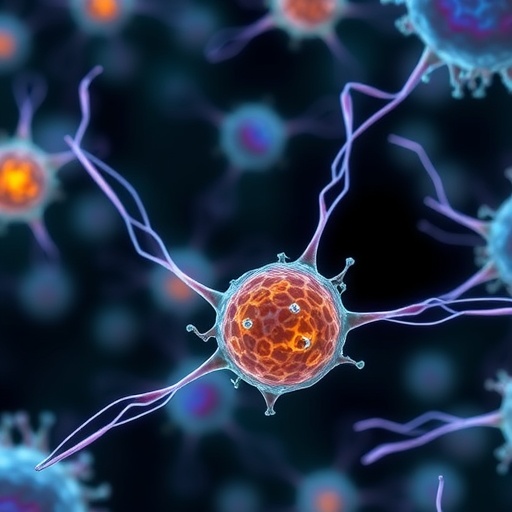In the intricate world of cellular biology, the production of proteins stands as one of the most essential processes sustaining life. At the heart of this phenomenon lies the ribosome, a remarkable molecular machine responsible for translating genetic instructions into functional proteins. For decades, scientists have understood the fundamental framework: DNA serves as the blueprint, mRNA conveys the coded instructions, and the ribosome meticulously assembles amino acids into the precise sequence dictated by the genetic code. Yet, despite this deep knowledge, a vital question remained unanswered — how does the ribosome know exactly when to stop making a protein, and what triggers the release of the newly formed protein at the precise moment?
The answer to this puzzle is crucial because premature or delayed termination in protein synthesis can lead to malfunctioning proteins, which are implicated in numerous diseases, including cystic fibrosis and Duchenne muscular dystrophy. Our understanding of protein release has traditionally hinged on the idea that a water molecule catalyzes the breaking of the bond between the completed protein chain and the transfer RNA (tRNA) in the ribosome, a process termed hydrolysis. However, water molecules are abundant and highly mobile within cells, which raises a significant question: if water is sufficient, why does the release not happen randomly or prematurely?
In a groundbreaking study recently published in Science, researchers from the University of Illinois Chicago have shed light on this molecular mystery. Through innovative methods and cutting-edge techniques, the team has revealed the precise chemical mechanism by which release factors mediate the termination of protein synthesis. Contrary to the traditional belief that a water molecule alone cleaves the bond to release the protein, the study demonstrates that the process is much more sophisticated, involving subtle structural rearrangements triggered by the release factor.
This discovery was enabled by a novel approach developed in 2022 by the lead researcher, Professor Yury Polikanov, and his colleagues. They engineered a non-hydrolyzable mimic of the tRNA-protein bond—a molecular analog resistant to cleavage by water. This clever molecular trap allowed the team to capture snapshots of the ribosomal machinery during the elusive final moments of protein synthesis, using high-resolution X-ray crystallography. By freezing the ribosome in this near-final state, the researchers were able to visualize how release factors orchestrate the protein release with an unparalleled level of detail.
What became evident from these visualizations was that water molecules are not positioned to directly break the bond. Instead, the release factor prompts the tRNA to adopt a slightly altered conformation. This subtle but crucial change in shape unleashes an intrinsic chemical potential within the tRNA itself, enabling it to participate actively in the hydrolysis reaction. In effect, the release factor does not deliver the catalytic water molecule; rather, it “nudges” the substrate, prompting the tRNA to catalyze its own cleavage and release the protein. This elegant mechanism ensures precise regulation, preventing uncontrolled or premature termination during protein synthesis.
Understanding this molecular choreography is more than a mere academic achievement. It reveals a fundamental principle of cellular precision and control, reflecting the exquisite evolution of life’s biochemical machinery. The fact that this mechanism appears conserved across all domains of life—from simple bacteria to complex human cells—underscores its universal importance. Protein synthesis termination is not a haphazard event but a carefully directed, enzyme-assisted process ensuring genetic fidelity and cellular functionality.
Professor Polikanov emphasizes that this finding overturns a longstanding conceptual model presented in textbooks and opens new avenues for exploring how translational accuracy is maintained. “We have not just uncovered how the release factor brings the necessary components together; we’ve shown how it repositions existing molecules allowing the system to complete the reaction autonomously,” he explains. This insight could have profound implications for biomedical research, particularly in understanding and potentially correcting errors in protein synthesis linked to genetic disorders.
Moreover, the detailed structural knowledge provided by this study offers promising possibilities for antibiotic development. Many antibiotics function by targeting bacterial ribosomes, halting their protein production capabilities. A clearer understanding of the termination phase could inspire novel drugs that specifically disrupt bacterial protein release without affecting human ribosomes, potentially minimizing side effects and resistance.
The research presented also highlights the power of interdisciplinary collaboration and methodological innovation. Combining molecular engineering to create non-hydrolyzable mimics, advanced crystallography to capture transient states, and precise biochemical assays, the team achieved what was once thought impossible—the direct observation and elucidation of a rapid, ephemeral biological process.
As scientific inquiry delves ever deeper into the minute workings of life’s machinery, revelations like this remind us of the immense complexity underlying seemingly simple biological events. The ribosome, often dubbed the “cellular 3D printer,” operates with a level of finesse and coordination that challenges our understanding of molecular mechanics. The newly discovered role of release factors and tRNA conformational dynamics opens new chapters not only in molecular biology but also in synthetic biology and therapeutic innovation.
In the grand tapestry of biology’s central dogma, this discovery fills a critical void by elucidating the molecular interplay underpinning the vital step of protein release. It reaffirms that life’s processes are governed by precise chemical interactions carefully vetted by evolutionary pressures. With each breakthrough, scientists move closer to mastering the fundamental codes of life, advancing both knowledge and technology in medicine and biotechnology.
The work of Polikanov, alongside collaborators Elena Aleksandrova and Egor Syroegin, represents a landmark contribution to the field, providing a definitive answer to a question that has intrigued researchers for decades. Their study is a testament to the power of modern science to unravel even the most complex mysteries embedded within the fabric of life.
Written by Tess Joosse
Subject of Research: Mechanism of protein release during translation termination on the ribosome
Article Title: Mechanism of release factor–mediated peptidyl-tRNA hydrolysis on the ribosome
News Publication Date: 19-Jun-2025
Web References: http://dx.doi.org/10.1126/science.ads9030
References: Aleksandrova et al., Science, 2025
Image Credits: Image credit to Aleksandrova et al
Keywords: ribosome, protein synthesis, translation termination, release factor, peptidyl-tRNA hydrolysis, molecular mechanism, x-ray crystallography, tRNA conformational change, cellular machinery




